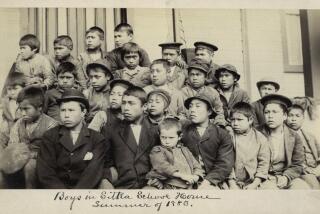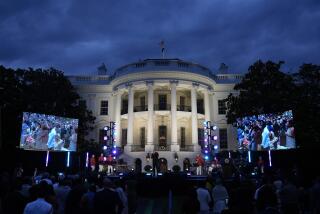Is It âInept Explorerâ Day? : American Indian UCI Educator Decries Columbus Deed She Calls an Invasion
TUSTIN â Billie Nave Masters got a frantic call recently from a schoolteacher asking her to make an emergency visit to an Orange County elementary school.
A 6-year-old student, it seems, had gotten wind of the fact that one of her classmates was an American Indian. So, fearful of being attacked by a bow and arrow, she had simply stopped coming to school, preferring instead to cower in the parking lot. Masters, a Cherokee Indian, knew just what to do. Donning traditional Indian dress, she gave a little talk to the students. Then, peeling off her leather-beaded jacket, she stood before them revealed as the professional educator--and non-threatening person--that she is.
âI wanted them to see that we are just like them,â said Masters, 55, speaking a few days before todayâs observance of the 500th anniversary of Christopher Columbusâ arrival in America.
The anecdote typifies the kind of public misconception that Masters encounters regularly as founding director of the Cherokee Language and Culture Institute at UC Irvine. Believed to be one of the few programs of its kind in the country, the institute offers a free two-week workshop each summer for anyone interested in learning the language of the Cherokees and studying their culture. It also collects and translates historical Cherokee letters, journals, literature and documents, and assists researchers looking into the history of the Cherokees and American Indians in general.
One of the most powerful tribes in 19th-Century America, the Cherokee nation--the only American tribe with a written language developed solely by Indians--once stretched through what is now Kentucky, Georgia, North Carolina and Tennessee. Yet most Americans, Masters says, have only the vaguest notion of who they were or, more important, what they and other American Indians are like today.
âThe museum concept of Indians is still prevalent,â she says. Rather than seeing American Indians as they are, she explains, most Americans view them as historical relics depicted in Hollywood movies or on museum shelves.
Mastersâ background uniquely qualifies her to help change that. Born in a two-room house with a dirt floor, she grew up and married on the Osage Indian Reservation in northeastern Oklahoma. Later she came to California with her husband who had joined the Navy. And though she now serves as supervisor of teacher education at UCI, Masters--who holds a doctorate in comparative culture from UCI--still maintains a home on the reservation and returns there at least once a month to visit.
âAll (of Indian culture) that exists continues to exist on the reservation,â she says. While the land and culture preserved on the Indian reservations is but a fraction of what it once was, she says, the reservations constitute the last pockets of that culture in the world. âWithout the reservation,â she says, âIndian culture would not continue.â
Yet contrary to the publicâs perception, Masters says, most American Indians now live in cities. Only 12% of their children go to reservation or Indian schools, she says. And in Los Angeles and Orange counties alone, about 140,000 American Indians represent 40 tribes, the largest pan-Indian population in the country.
âItâs an invisible minority,â she says. âMany go unrecognized or are counted as Hispanics. We are computer analysts, barbers, teachers, preachers, nurses and doctors; Indians are everywhere. Weâre probably the most adaptable civilization in the world.â
One thing they are tired of adapting to, however, is bastardizations of their history, according to Masters. Take Columbus Day. Far from being a hero, she says, Columbus was an inept explorer who inadvertently stumbled on a civilization that he little understood or appreciated. And far from discovering a ânew world,â she says, he unwittingly created a bridge between two old worlds which eventually merged in a way that nearly destroyed one.
âColumbus Day ought to be called American Invasion Day,â Masters says.
Part of the problem, she says, stemmed from the entirely different world views held by the early Indians and the European explorers. While Indians viewed themselves as in harmony with nature and non-competitive with other humans, she says, the Europeans saw themselves as competitors in a world populated by winners and losers.
âLife is a circle, not a pyramid,â Masters says, reflecting the Indian view. âIf the Europeans had understood that there was no hierarchy, history would have been different.â
Instead, she says, Americaâs natural beauty (virtually untouched by European standards) prompted the white visitors to view it as âvirgin landâ despite the fact that as many as 70 million people lived here. What ensued was a period of âeconomic, cultural and religious genocideâ that the Indians barely survived. The fact that they did, Masters maintains, is worthy of celebration rather than Columbus Day.
But she doesnât spend her time protesting. When she isnât making cultural presentations at elementary schools, Masters--who has seven grown children, including five who are adopted--is often busy writing school curricula fully incorporating the Indian story. She sits on the California State Legal Compliance Commission, a group responsible for reading textbooks to assure the equal treatment of women and minorities. And as a member of the National Education Assn. Minority Affairs Advisory Committee, she lectures frequently on American Indian subjects and helps out at the Southern California Indian Center in Garden Grove which, among other things, sponsors an annual powwow.
At UCI she divides her time among supervising student teachers in the education department, assisting researchers to correct the misnomers of American Indian history, and planning the Cherokee instituteâs annual workshop, generally attended by 20 to 40 students. They have come from all walks of life; American Indian students wanting to learn more about their culture, social workers wishing to better understand their Indian clients and even a screenwriter wishing to accurately portray Indians in a script.
Underlying everything, however, is a profound appreciation for the plight of Americaâs original inhabitants whose security and happiness, Masters says, was promised by the U.S. government in more than 700 broken treaties signed with the Indians over many years in exchange for land and peace.
âWeâre not about beads and feathers anymore,â she says of her people. âWeâre about health care, education, economic development, land rights and water rights. Weâre talking about people here; if today we could take those treaties and implement them, the Indians wouldnât have any complaints.â
And what of Columbus Day?
Masters says she has no special plans for celebrating it, except maybe one. She intends to spend some extra time with some of her 23 grandchildren in a discussion of who really discovered America. âTheyâll be hearing a lot at school,â she explains. âI need to be there to help them sort it out.â
More to Read
Sign up for Essential California
The most important California stories and recommendations in your inbox every morning.
You may occasionally receive promotional content from the Los Angeles Times.










